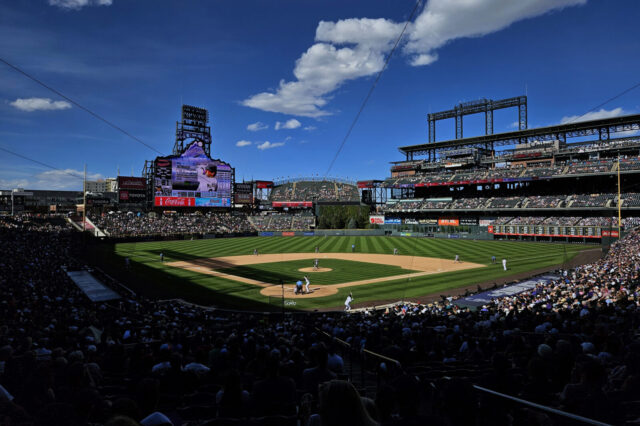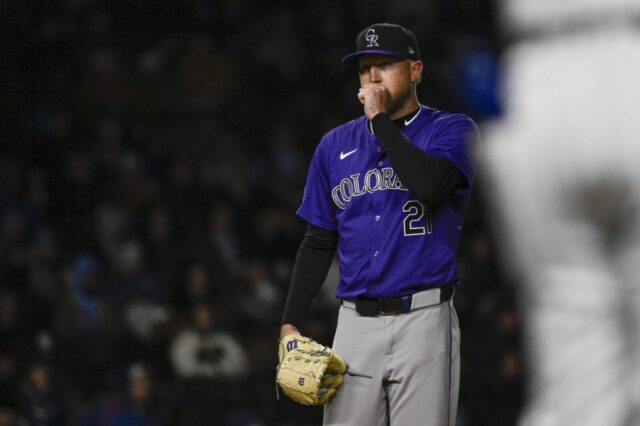I don’t know who first used the baseball cliché, “The season is a marathon, not a sprint.”
A quick glance at Google search results reveals contemporary names like Stephen Strasburg rolling out the expression as recently as February. Dig a little deeper and you can trace it back more than a decade to Ozzie Guillen, whose heyday was in the ’80s and ’90s. Keep digging and you can find men like Art Stewart, who shaped the league as far back as the late 1950s, putting it to use.
When and where the phrase originated is of only minor consequence here. But I do feel confident in saying that whoever first used it was not talking about the Colorado Rockies.
Yet, we enter the penultimate day of May 2017 and it’s oh-so-tempting to apply it with the Rockies. With wins on Wednesday and Thursday the Rockies will end the second month of the season atop the NL West, regardless of what the Dodgers and Diamondbacks do.
Now in their 25th season, the Rockies are still seeking their first win in the annual National League West race. No matter how well they’ve come out of the gates or finished down the stretch, they’ve never outpaced the competition in the division over the long haul.
That’s because the Colorado Rockies aren’t running a marathon like the rest of baseball.
If the season is a marathon for the other 29 teams in Major League Baseball, it must feel like the Leadville 100 for the Colorado Rockies.
For those who aren’t familiar, the Leadville 100 is an ultra-marathon beginning and ending in Leadville, Colo. The 100-mile race begins at an elevation of 10,200 feet above sea level and involves more than 15,000 feet of vertical climbing.
Winning the NL West, if you’re the Los Angeles Dodgers, has been like the Bolder Boulder 10K in comparison.
Consider this: For the past four years, the Dodgers have claimed baseball’s highest payroll. They’ve been in the top 10 since 2011, as has fellow NL West stalwart San Francisco. The Rockies, in that time, have never ranked higher than 16th (where they sit this year); their average spending has ranked 19.57 in the MLB over that span.
Like the runners of the Leadville 100, the Colorado Rockies have to be leaner and meaner than their seaside, road-running competition. But that’s not to say that money is everything.
Even when the Rockies have spent freely, it hasn’t translated to success in the division. They pulled up lame with Mike Hampton and Denny Neagle. Todd Helton’s big money got them to the finish line more than once, but never in first place. And Troy Tulowitzki and his big fat paychecks ended in the medical tent more often than they did on the podium.
That’s because running the race at altitude puts a completely different strain on the human body.
Altitude is consistently blamed for the lack of break on pitches, the extra 10 percent travel the ball gets off the bat and the strain it puts on the lungs when legging out a triple at Coors Field. All of those are valid complaints for why playing 81 games at Coors Field makes it a home field “disadvantage” for the Colorado Rockies. But what is often overlooked when it comes to playing at altitude is the long-term strain it puts on a player’s body.
As oxygen levels decrease, so too does the body’s ability to rebuild and repair itself. Visiting players might feel winded faster than Charlie Blackmon or Jon Gray in a single game, but over the course of a six-month season the Colorado Rockies will endure greater physical strain than any other club in the majors simply by spending half the year with 17 percent less oxygen than teams playing at sea level.
Running 26 miles is nothing when your lungs are filled with the oxygen-rich air of the Pacific Coast. Try going for even longer at a mile high. Because most games played in the Mile High City take longer.
With its cavernous outfield, Coors Field ranks second in baseball in “park factor runs.” More runs means more hits allowed, which means more pitches thrown, which means even greater strain on the pitching staff. It means more base hits to track down, more plays to make on runners, more trips around the bases, and more wear and tear on position players.
The Dodgers are near the MLB mean at a park factor ranking of 15th, while the Padres and Giants rank 20th and 30th respectively. The D-Backs actually have the only higher park factor than the Rockies; however, those games are played in the climate-controlled environment of Chase Field. Needless to say, the Diamondbacks will never play a game with the first pitch temperature registering at 23 degrees Fahrenheit.
Like the Mosquito and Sawatch Ranges surrounding Leadville, Coors Field might be one of the most picturesque places to compete, but it’s also one of the toughest to survive. The Rockies will play 71 more games there than any other team.
None of this is to make excuses for the Rockies, or to justify why they’re still seeking that elusive first division title after all these years. The Rockies enter the race year after year. They know what to expect.
But fans are entering uncharted territory. For the first time in franchise history the Rockies have the chance to be atop the NL West at the end of May.
This is, instead, intended to temper enthusiasm. Whether you want to call it a marathon an ultra-marathon or anything else, the baseball season is indeed a long race.
In 24 seasons prior, Colorado has only been in first place in the NL West in the month of May or later in four of them. Winning here is historically hard.
The last two times the Rockies made the playoffs, 2009 and 2007, they were in dead last place in the NL West on May 31. Slow starts and fast starts mean little.
This year, the Dodgers and Diamondbacks are nipping at Colorado’s heels. Both could pass the Rockies by June 1 or sooner.
The Dodgers have won the division four years running. The Giants have won it twice since 2010 and the Diamondbacks once. They all know what a winning race feels like.
It’s worth being excited about this Rockies team, which is off to the best start in franchise history. Just remember, it’s a long race to finish first in the NL West.



